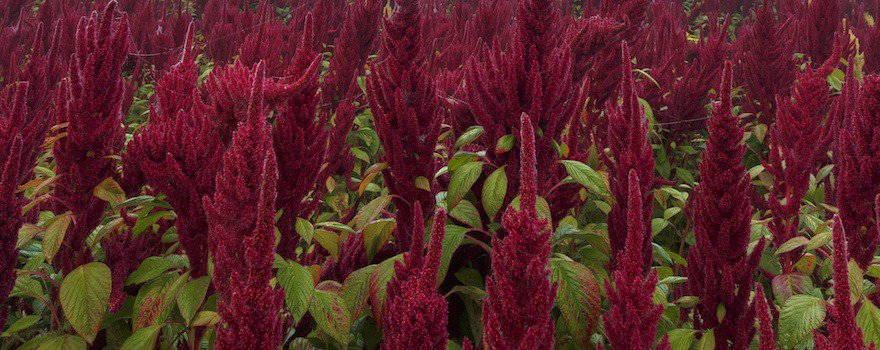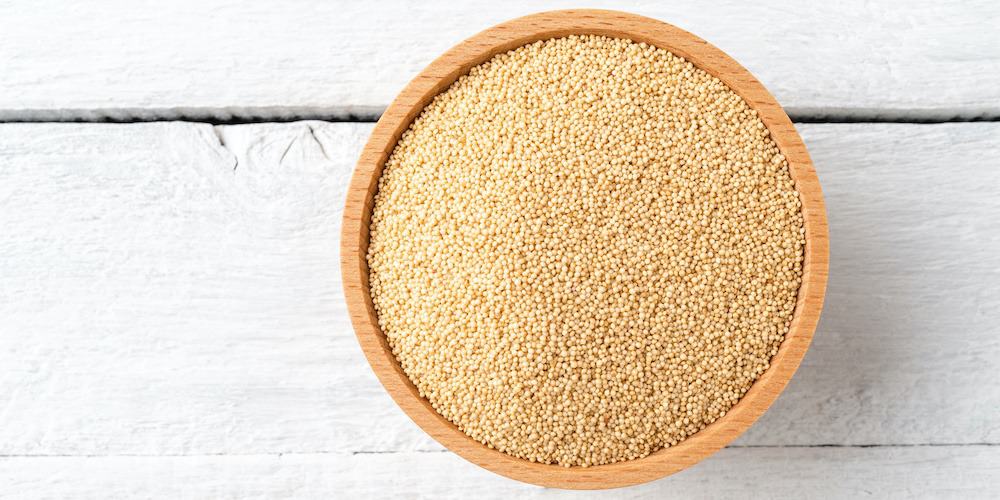BENEFITS OF AMARANTH
✓ Source of protein
✓ Reduces cholesterol levels
✓ Source of antioxidants
✓ Anti-inflammatory
✓ Aids in weight loss
What is amaranth?
Amaranth (Amaranthus) is a plant belonging to the Amaranthaceae family, which includes over 800 different species. Among the most cultivated and consumed are white amaranth (Amaranthus albus), foxtail amaranth (Amaranthus caudatus), and red amaranth (Amaranthus blitum). All are native to the temperate and tropical regions of Central America.
Like buckwheat, it is a pseudo-cereal: it is not a cereal (it is not part of the grass family) but its seeds are consumed similarly. The leaves of the plant are also edible.
During pre-Colombian civilizations, it was part of the staple diet of the Incas in Peru and the Mayas and then the Aztecs in Mexico.
The first traces of its cultivation date back between 5,000 and 7,000 years. Prepared in different ways (beverages, sauces, flatbreads…), it was appreciated for its nutritional characteristics.
Long forgotten, it made a comeback on our plates in the 1970s. This highly nutritious pseudo-cereal is beneficial in many ways. An excellent source of plant-based proteins, it also helps reduce cholesterol levels, protects the body from free radicals, and relieves inflammation. Additionally, its fiber content supports weight loss.
Nutritional composition
- Amino acids
- Vitamins: A, B2, B3, B5, B6, B9, C, E, K
- Minerals and trace elements: iron, calcium, magnesium, manganese, phosphorus, potassium, copper, zinc, selenium
- Proteins
- Carbohydrates
- Fiber
- Antioxidant compounds: gallic acid, p-hydroxybenzoic acid, vanillic acid, squalene
- Fatty acids: omega-3, omega-6

The benefits of amaranth
🌿 Source of protein
Amaranth seeds are an excellent source of plant-based proteins. Thus, 100 g of seeds contain about 14 g of protein, more than most legumes or dried vegetables. The seeds are therefore beneficial for vegetarians or vegans to compensate for the lack of animal protein intake.
Moreover, these proteins are complete: like those found in buckwheat and quinoa, they contain all the essential amino acids.
This review from the University of Natural Resources and Life Sciences in Vienna (Austria) highlights the nutritional interest of amaranth.
🍳 Reduces cholesterol levels
Amaranth has cholesterol-lowering properties: it lowers total cholesterol and LDL cholesterol (or “bad cholesterol”) levels. At the same time, it increases HDL cholesterol (or “good cholesterol”) levels.
This action seems to be due to tocotrienol, a form of vitamin E with beneficial effects on cholesterol metabolism, and squalene, an antioxidant acid involved in regulating cholesterol levels.
This study from the pharmaceutical company Cytochroma Inc. (Canada), conducted on hamsters, shows how amaranth oil reduces cholesterol levels.
🥝 Source of antioxidants
Amaranth contains powerful antioxidant compounds. It notably includes phenolic acids, such as gallic acid, p-hydroxybenzoic acid, and vanillic acid. All effectively combat free radicals and prevent their damage to cells and organs, such as the liver.
This antioxidant action protects the body against many diseases linked to the harmful effects of free radicals: cardiovascular diseases, cancers, neurodegenerative diseases…
This study from the National University of San Luis (Argentina), conducted on rats, demonstrates the antioxidant activity of amaranth seeds.
🔥 Anti-inflammatory
Consuming amaranth may also help reduce inflammation. The plant has shown to be particularly beneficial in cases of chronic inflammation during allergies or autoimmune diseases. It does this by preventing the activation of the NF-κB protein, which is involved in the body’s inflammatory response. Additionally, it inhibits inflammation induced by lipopolysaccharide (LPS), which promotes the release of pro-inflammatory cytokines.
This study from the University of Illinois (USA), conducted on human and mouse macrophages, explains the mechanism of amaranth’s action against inflammation.
🏃🏻♂️ Helps with weight loss
In addition to proteins, amaranth also contains a significant amount of dietary fiber: about 5 g per 100 g. By swelling and forming a viscous gel in the stomach, they speed up the feeling of fullness and act as natural appetite suppressants. It can be a valuable aid to limit snacking during the day and support weight loss.
This study from the Defence Food Research Laboratory (India), conducted on rats, shows how amaranth consumption promotes satiety and contributes to weight loss.

How to consume amaranth?
Amaranth seeds
Commercially available amaranth seeds are cooked, with a subtle nutty flavor. Simply immerse 1 part seeds in 2 parts water and cook for 15-20 minutes.
Let them swell and prepare like a tabbouleh. Cooked seeds are also ideal for making porridge, vegetarian patties, soups… You can add them raw to muesli or prepare them like popcorn to get puffed amaranth seeds.

Amaranth leaves
Amaranth leaves are consumed like spinach and have a very similar taste. They are served as a side dish with meat, fish, vegetables, gratins… They can also be made into pies and soups.
Amaranth flour
Amaranth flour comes from ground seeds and is listed among the gluten-free flours. It is ideal for celiac individuals when combined with other gluten-free flours like buckwheat, lupin, rice, or carob flour.
You can use it to make breads, cakes, cookies, pancakes… accounting for 1/3 of the preparation. The flour has the advantage of adding softness to recipes.
Sustainable consumption: prioritize organic and fair-trade amaranth
✓ Amaranth is primarily grown in Latin America: Argentina, Peru, Bolivia, Mexico… Due to increasing demand, its cultivation has gradually spread to Europe and parts of North America. However, it remains underdeveloped in France. Although our climate is favorable for its cultivation, it offers lower yields than traditional cereals and suffers from its “weed” stigma.
✓ If you wish to discover this pseudo-cereal, we recommend choosing seeds from organic agriculture and, if possible, fair-trade sources. This way, you’ll support the work of producers and small-scale farming.
Dosage
You can consume between 60 and 80 g of amaranth per day (seeds or leaves).
Contraindications and side effects
Consuming amaranth presents some contraindications:
- Because its leaves contain oxalic acid (responsible for kidney stones), they should not be consumed in excess
- People suffering from pancreatitis, cholecystitis, gallstones, and urolithiasis should avoid consuming them
- Amaranth is not recommended for people allergic to wheat due to possible cross-allergy
Excessive consumption can lead to some side effects:
- Nausea
- Vomiting
- Dizziness
- Allergic reaction
If you experience side effects, stop consumption and consult a doctor.
History, culture, and market of amaranth
For several years, certain species like Palmer’s amaranth (Amaranthus palmeri) have challenged herbicide manufacturers. Indeed, they are capable of adapting and even thriving in treated fields thanks to their impressive ability to multiply.
An amaranth plant can produce and disperse up to 12,000 seeds per year! Today, it is widely studied for its resistance to herbicides such as glyphosate.
Sources and scientific studies
Narpinder Singh, Prabhjeet Singh, 2011. Amaranth: Potential Source for Flour Enrichment.
Stefano D’Amico, Regine Schoenlechner, 2017. Amaranth: Its Unique Nutritional and Health-Promoting Attributes.
Alvin Berger, Gérard Gremaud, Marcel Baumgartner, Dietrich Rein, Irina Monnard, Elena Kratky, Wolfgang Geiger, Joseph Burri, Fabiola Dionisi, Martin Allan, Pierre Lambelet, 2003. Cholesterol-lowering properties of amaranth grain and oil in hamsters.
Alvaro Montoya-Rodríguez, Elvira González de Mejía, Vermont P Dia, Cuauhtémoc Reyes-Moreno, Jorge Milán-Carrillo, 2014. Extrusion improved the anti-inflammatory effect of amaranth (Amaranthus hypochondriacus) hydrolysates in LPS-induced human THP-1 macrophage-like and mouse RAW 264.7 macrophages by preventing activation of NF-κB signaling.
M V Mithila, Farhath Khanum, 2015. Effectual comparison of quinoa and amaranth supplemented diets in controlling appetite; a biochemical study in rats.
Jose Alfredo Dominguez-Valenzuela, Javid Gherekhloob, Pablo Tomás Fernández-Moreno, Hugo Enrique Cruz-Hipolito, Ricardo Alcántara-de la Cruz, Eduardo Sánchez-González, Rafael De Prado, 2017. First confirmation and characterization of target and non-target site resistance to glyphosate in Palmer amaranth (Amaranthus palmeri) from Mexico.



